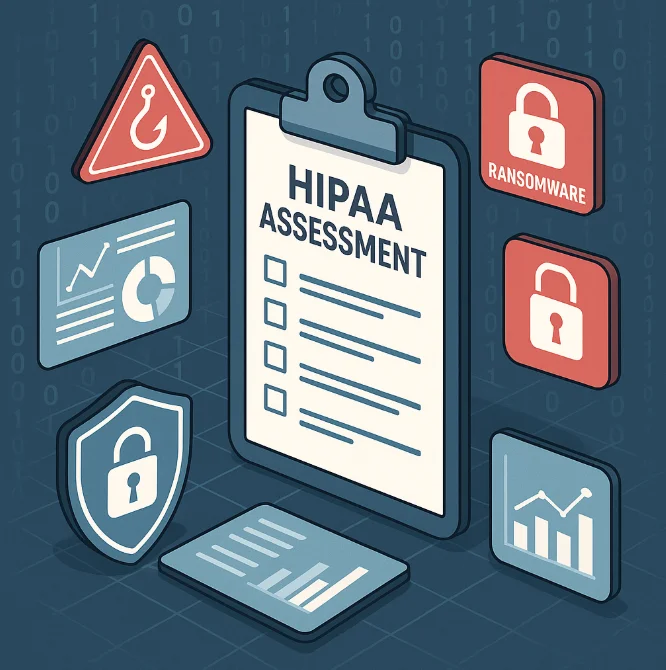The Importance of HIPAA Risk Assessments for Healthcare Practices — And How to Conduct Them Effectively

The security of information about a patient should not be viewed only as a good practice in the field of healthcare, but it is also a regulation. The Health Insurance Portability and Accountability Act (HIPAA) has laid strict guidelines for protecting the protected health information (PHI). However, risk assessment is an area where most healthcare practices do not perform well. A thorough and regular HIPAA risk assessment is not only a regulatory requirement but also a vital step in preventing data breaches and maintaining patient trust.
What Is a HIPAA Risk Assessment?
A HIPAA risk assessment is a systematic process that helps healthcare organizations identify potential threats and vulnerabilities to the confidentiality, integrity, and availability of electronic protected health information (ePHI). It will check the extent of protection to those risks by existing safeguards in an organization and will determine the areas that require improvement.
The HIPAA Security Rule provides that every covered entity and business associate should carry out its risk assessment exercise as a continuous practice of adhering to HIPAA standards. The evaluation should be done comprehensively, recorded, and updated frequently to correspond to modifications in organizational activities or technology applications.
Why Is a HIPAA Risk Assessment So Important?
Most of the practices are under the impression that as long as they have the basic security measures in place, they are compliant. Nevertheless, even the systems with an outward appearance of security might present loopholes, violating HIPAA compliance, without a documented and updated risk assessment.
A proper HIPAA risk assessment helps to:
- Identify and mitigate vulnerabilities before they are exploited.
- Avoid costly penalties from the Office for Civil Rights (OCR) for noncompliance.
- Protect your practice’s reputation and maintain patient trust.
- Ensure all technical and administrative safeguards are functioning correctly.
- Guide your overall compliance strategy with actionable insights.
Key Components of an Effective HIPAA Risk Assessment
To take full advantage of your assessment and to be in compliance with your risk, your risk assessment must comprise the following procedures:
1. Data Inventory and Mapping
Begin by determining all of the ePHI that is collected, stored, transmitted, or accessed by your practice. These are patient records, billing systems, as well as emails, cloud storage, and mobile devices.
2. Find Threats and Vulnerabilities
Assess what may jeopardize or damage your ePHI. These are cyber threats (such as phishing or ransomware), physical threats (such as unauthorized access), and internal risks (such as employee negligence).
3. Evaluate the Level of Security
Assess the type of technical, physical, and administrative safeguards they have in place. Are they appropriate to the scale and level of your practice?
4. Establishing levels of risk: Determine risk levels
Identify the probability of the occurrence of each vulnerability and the level of effect on an organization. This will enable you to rank risks according to severity.
5. Design Remediation Plan
After the identification of the risks, design an action plan to address the weaknesses. This can encompass an updated software, better training of the employees, or even the improvement of the access controls.
6. Make a Document and Review Periodically
HIPAA stipulates that your risk assessment should be properly documented. It is to be reviewed and updated once a year at least, or in cases where there is a major change in the systems or policies you have in place.
Common Mistakes to Avoid
- Broad-based templates that are not relevant to your operations
- There is a lack of re-evaluation after the establishment of new technology.
- Ignoring mobile and remote devices accessed to obtain ePHI
- Failure to undergo the employee training, depending on the results of the risk assessment
These are the pitfalls you should evade to have a meaningful and compliant risk assessment.
Conclusion
A HIPAA risk assessment is not a one-time task—it’s a continuous effort that should evolve with your healthcare practice. By carrying out thorough annual evaluations, you can make sure your company is defended against data leaks, consistent with the standards mentioned in the federal outline, and able to provide safe, unexposed treatment. By prioritizing your HIPAA risk assessment process, you build a stronger, more resilient foundation for your practice and your patients alike.

How low-code platforms are transforming digital account opening in US Banks

Complete Guide to Accounting Vouchers in Tally: Learn Accounting, Inventory & Order Vouchers

Businessnewstips.co.uk – Your Trusted Source for Business Insights and Market Trends

Accelerating drug discovery through the DEL-ML-CS approach

AI in Marketing Is No Longer a Buzzword — It’s the Strategy

Breathing Techniques for Exercise: Boost Endurance and Recovery

The Importance of HIPAA Risk Assessments for Healthcare Practices — And How to Conduct Them Effectively

The Invisible Toll of Sleep Deprivation on New Parents








